

The independent action hypothesis (IAH) states that each virion has an equal, nonzero probability of causing an infection. [2]. A cotton tshirt blocks 69% of particles of 1μm particles [3] (is that radius or diameter?). Given all this it seems very likely to me that cotton masks reduce the probability of transmission.
Notes & references
----
1 - - -
Counter Aguments to "Masks don't work" List Of SEVENTY Studies Providing Evidence For Wearing Masks. If someone asks: What’s the evidence for mask wearing?

Here is a list of *SEVENTY* papers, including reviews/meta-analysis and individual studies, in reverse chronological order. This list also includes 31 from 2020 alone! META = meta-analysis or systematic review. 1 “Visualizing the effectiveness of face masks in obstructing respiratory jets,” Verma et al., June 30 2020, Phys Fluids: … “Community Use Of Face Masks And COVID-19: Evidence From A Natural Experiment Of State Mandates In The US” Lyu et al., June 16 2020, Health Affairs: … “Association of country-wide coronavirus mortality with demographics, testing, lockdowns, and public wearing of masks” Leffler et al., June 15 2020, medRxiv: …
Memes - masks - covid-19. Droplet Dynamics (Masks - COVID-19) Mask Making (COVID-19) Mask Politics (COVID-19) Economic Arguments - masks - COVID-19. Should the public wear masks? Wearing a mask can significantly reduce coronavirus transmission: Study. As the debate over the effectiveness of wearing masks during a pandemic continues, a new study gives weight to arguments by medical professionals and government leaders that wearing a mask does indeed reduce virus transmission — and dramatically so.

Experiments by a team in Hong Kong found that the coronavirus’ transmission rate via respiratory droplets or airborne particles dropped by as much as 75% when surgical masks were used. “The findings implied to the world and the public is that the effectiveness of mask-wearing against the coronavirus pandemic is huge,” Dr. Yuen Kwok-yung, a leading microbiologist from Hong Kong University who helped discover the SARS virus in 2003, said Sunday.
The study was released by the department of microbiology at The University of Hong Kong, and local media state it will be published in the Clinical Infectious Diseases medical journal, suggesting it is yet to be peer reviewed. The sample size was also reportedly in the double digits. What We Need to Understand About Asymptomatic Carriers… ProPublica is a nonprofit newsroom that investigates abuses of power.
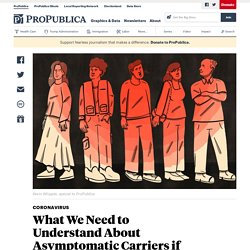
Sign up to receive our biggest stories as soon as they’re published. In the early days of the coronavirus outbreak in the U.S., around the last week of February, I joked to a colleague that maybe now, finally, people would learn how to wash their hands properly. My remark revealed a naive assumption I had at the time, which was that all we needed to do to keep the novel coronavirus contained was follow a few simple guidelines: stay home when symptomatic and maintain good personal hygiene.
The problem, I thought, was that nobody was following the rules. NPR Choice page. Optimizing the use of masks and respirators during the COVID-19 outbreak. On this page Importance of masks and respirators Masks and respirators (personal respiratory protective devices) are essential during the COVID-19 outbreak.
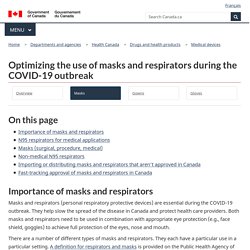
They help slow the spread of the disease in Canada and protect health care providers. Both masks and respirators need to be used in combination with appropriate eye protection (e.g., face shield, goggles) to achieve full protection of the eyes, nose and mouth. There are a number of different types of masks and respirators. N95 respirators for medical applications N95 respirators (or particulate filtering face-piece respirators) are Class I medical devices.
N95 respirators achieve a minimum filtration efficiency of 95% when worn properly. Addressing COVID-19 Face Mask Shortages [v1.2] Considerations in the use of homemade masks to protect against COVID-19. Notice to General Public and Healthcare Professionals.
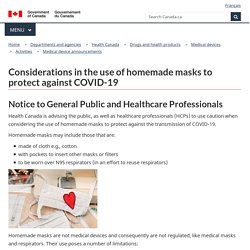
Optical microscopic study of surface morphology and filtering efficiency of face masks. - PubMed - NCBI. Covid-19: To mask or not to mask? — Dr Amar-Singh HSS. APRIL 3 — As we enter the second phase of our movement control order (MCO) and start to plan for the future, there are many issues that need to be thought through and one of them is whether we should wear masks more often.
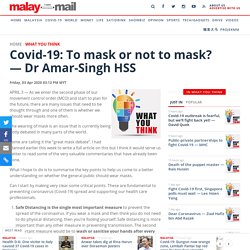
The wearing of mask is an issue that is currently being hotly debated in many parts of the world. Some are calling it the “great mask debate”. I had planned earlier this week to write a full article on this but I think it would serve us better to read some of the very valuable commentaries that have already been done. What I hope to do is to summarise the key points to help us come to a better understanding on whether the general public should wear masks. Can I start by making very clear some critical points. Safe Distancing is the single most important measure to prevent the spread of the coronavirus.
Can homemade face masks help limit the spread of the coronavirus? Scientists can't agree, but here's what you need to know. The White House recommended on Friday that all Americans wear masks, and some US cities like Los Angeles and Laredo, Texas are fining people who don't cover their faces during the coronavirus pandemic.
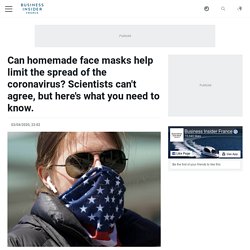
But the public has also been urged to avoid buying medical masks because there is a global shortage, and healthcare workers, who are most exposed to the virus, need them.Instead, it's been suggested that people make their own masks from fabric, or use a bandana or scarf wrapped around the mouth and nose. Here's what we know so far about effectiveness of various types of homemade masks to protect against coronavirus, and why it's so hard for experts to agree on whether we should wear them.
Visit Business Insider's homepage for more stories. The White House announced on Friday a nationwide recommendation that all Americans wear masks to help slow the spread of the novel coronavirus across the nation.
Mask Re-Use (COVID-19) Pore size (Masks COVID-19) Derek K Chu, Physical distancing, face masks, and eye protection to prevent person-to-person transmission of SARS-CoV-2 and COVID-19: a systematic review and meta-analysis. Masks - plandemic. Airborne transmission (COVID-19) Non-pharmaceutical interventions (modelling)
COVID-19 strategies. COVID-19.